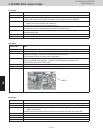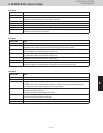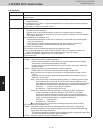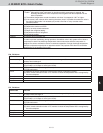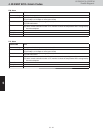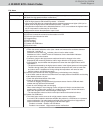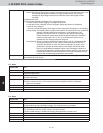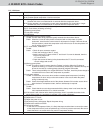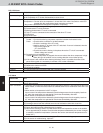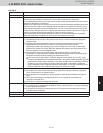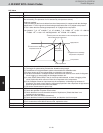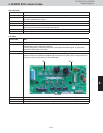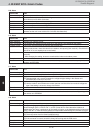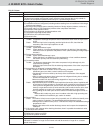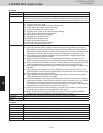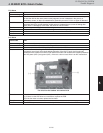
5
5 - 18
4. W-2WAY ECO-i Alarm Codes
W-2WAY ECO-i SYSTEM
Trouble Diagnosis
H03, H13 Alarm
Alarm code H03, H13
Alarm meaning H03: Compressor 1 CT sensor disconnected or short-circuit
H13:
Compressor 2 CT sensor disconnected or short-circuit
Alarm conditions Compressor 1: Current value of more than 18.0 A is detected while the compressor 1 is stopped.
Compressor 2: Current value at compressor 2 is less than 2.0 A when 2 seconds or more had
passed after the compressors began operation and output.
* No current is detected even though the compressor is operating.
Probable cause (1) CT circuit failure (including cut wiring, etc.)
(2) Disconnected CT circuit connector
(3) Missing phase where CT circuit is connected
(4) This CT circuit is connected to the connector of the other CT circuit.
(5) PCB failure
(6) Electrical noise
Check (1) CT circuit failure, PCB failure
Trouble: • Current value during compressor operation is below the threshold value.
Check: • Check that the connector is not disconnected.
Check the continuity of the CT circuit.
Install a normal CT in place of this CT and check. If current is detected, then the
PCB can be judged OK.
→
CT circuit failure
Check that current is fl owing in the phase where the CT circuit is connected.
→
Check voltage and current.
(2) Crossed wiring or installation error
Trouble: When the compressor is stopped, the current value at the other compressor is high.
When this type of condition occurs, seizing-detection control takes priority.
(3) If the cause is still unknown after checking the above, then it is possible that noise is the
cause of the trouble. It is necessary to connect a PC or other instrument.
•
•
•
Correction (1) Replace the CT circuit.
(2) Replace the outdoor unit PCB.
(3) Correct the problem.
Example (1) The connector was not inserted after the PCB was replaced.
Notes Use a normal CT as a tool to determine whether the trouble is a PCB failure or CT failure.
H15 Alarm
Alarm code H15
Alarm meaning Compressor 1 discharge temperature sensor disconnected; Compressor 2 discharge temperature
sensor disconnected
Alar
m conditions
This alarm occurs when the discharge sensor temperature detector is not inserted into the tube’s
sensor holder, or when the sensor itself has suffered some kind of malfunction other than a cut
wire.
When outdoor air temperature is 50°F or higher:
Alarm occurs if the temperature detected by the discharge sensor has changed by less than
4°F when the compressor has operated for 10 minutes immediately after start.
When outdoor air temperature is below 50°F:
Alarm occurs if the temperature detected by the discharge sensor has changed by less than
4°F when the compressor has operated for 30 minutes immediately after start.
•
•
•
Probable cause (1) Discharge sensor temperature detector is not inserted into the tube’s sensor holder.
(2) Discharge sensor itself has suffered some kind of malfunction other than a cut wire.
Check (1) Check that the discharge temperature sensor is inserted into the sensor holder.
(2) Check that suffi cient heat-conducting putty is applied.
(3) Remove the discharge sensor from the sensor holder and expose the sensor to the outside
air for approximately 5 minutes. Check that the temperature detected by the sensor changes
to match the outside air temperature. (However the sensor cannot detect temperatures at or
below 32°F.)
Correction (1) Install the sensor into the holder, and apply suffi cient heat-conducting putty.
(2) If the sensor is malfunctioning, replace it.
Example



